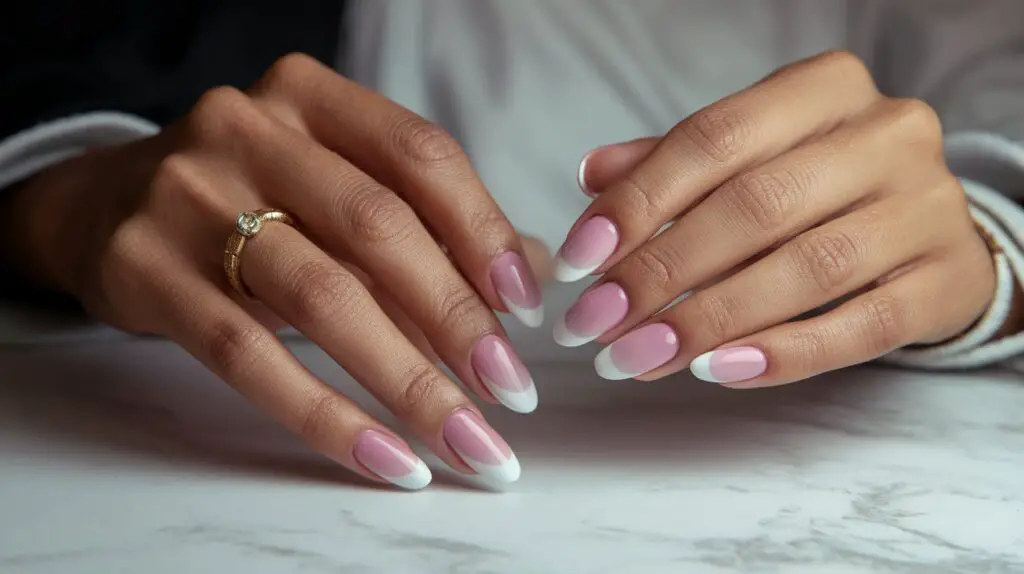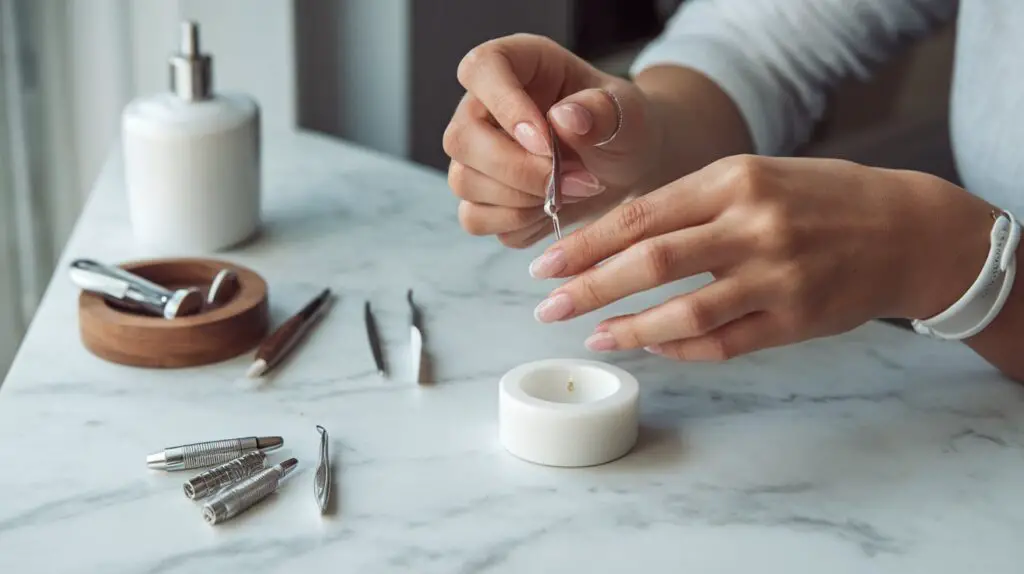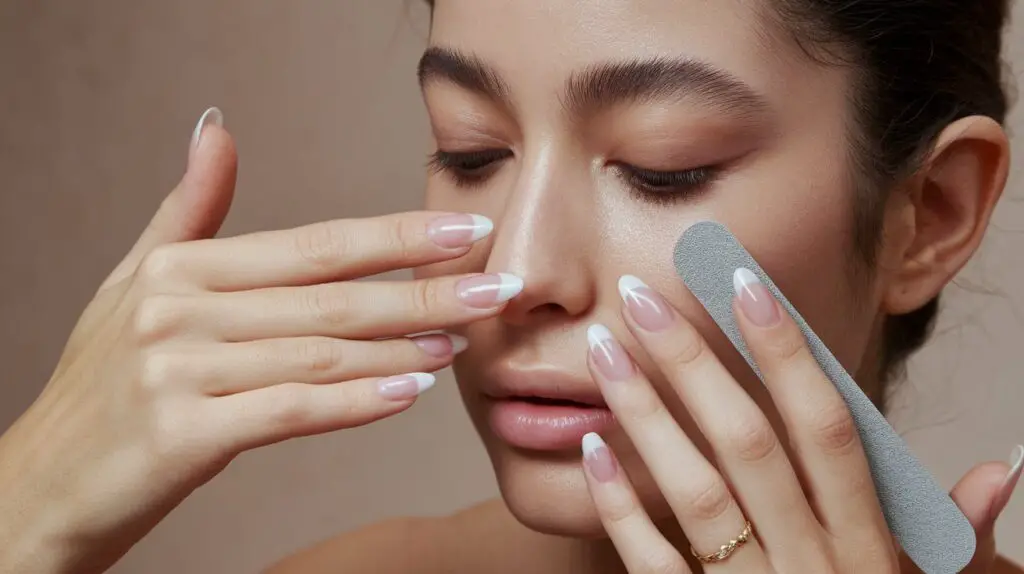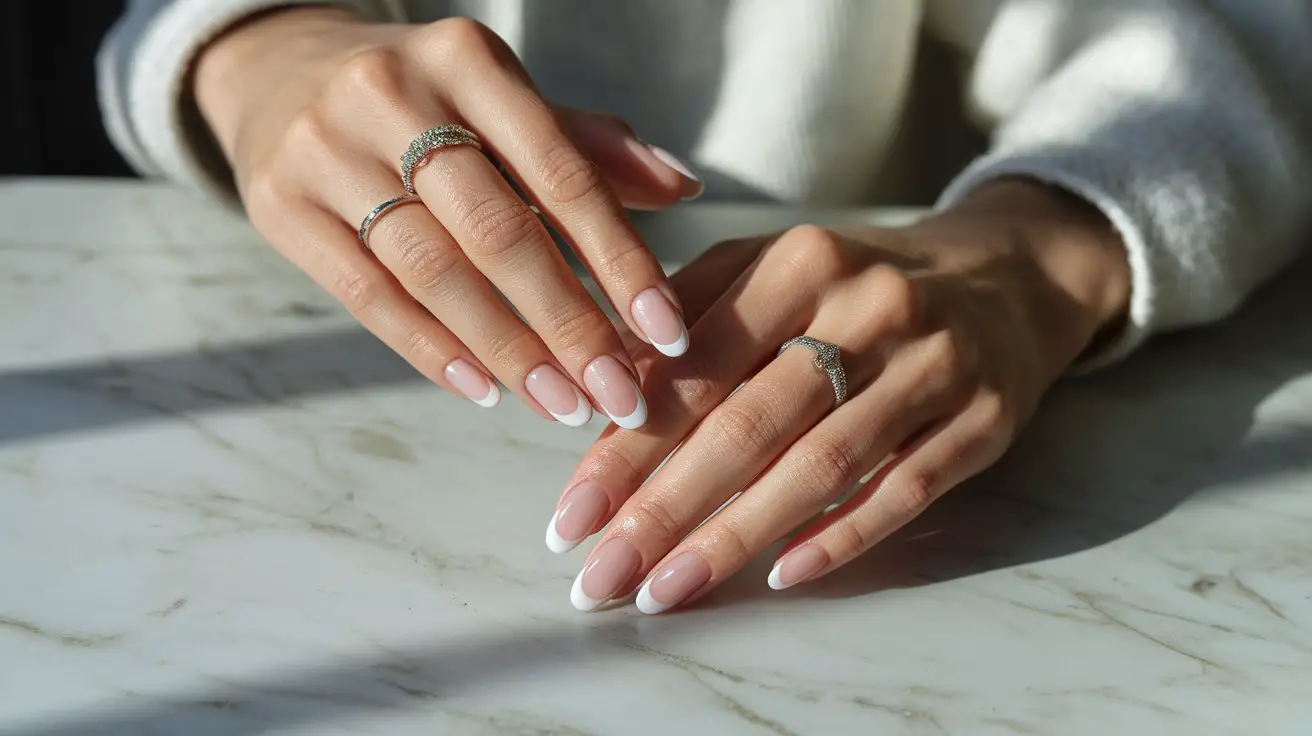The classic French manicure has evolved into an artistic expression with the addition of color transitions. This modern take on the traditional style combines the elegance of white tips with subtle color gradients, creating a sophisticated look perfect for any occasion. The technique allows women to customize their manicure while maintaining the timeless appeal of French tips.
Creating this look at home requires specific tools and a steady hand, but the results are worth the effort. A good-quality base coat, white polish, color choices for transitions, and the right brushes make all the difference in achieving a professional finish. With practice and patience, this sophisticated nail design becomes easier to master.
The following sections will guide you through each step of creating beautiful transitional French tips. From proper nail preparation to mastering color gradients and achieving clean white lines, you’ll learn the techniques needed for a flawless finish. Let’s discover how to transform basic French tips into an elegant masterpiece with color transitions that will make your nails stand out.
- What Makes a French Manicure with Color Transitions Different?
- How Do You Prepare Nails for a Perfect French Manicure?
- What Are the Best Techniques for Creating Color Transitions?
- Master the Perfect White Tips
- How to Make Your Transitional French Manicure Last?
- Your Perfect French Manicure Journey
- Frequently Asked Questions
What Makes a French Manicure with Color Transitions Different?

A French manicure with color transitions takes the classic white-tipped design into a new dimension of nail artistry. This modern interpretation adds subtle color shifts between the traditional pink base and white tips, creating a sophisticated gradient effect that catches the eye.
Traditional vs Transitional French Manicure
The traditional French manicure features a clean white tip against a natural pink base. However, the transitional version introduces a gentle color flow between these two elements. Think of it as painting a sunset on your nails – where one color smoothly flows into another without harsh lines.
The main differences between these two styles lie in their application and final appearance:
- Base color complexity: Traditional uses one solid pink shade, while transitional incorporates multiple hues
- Application technique: Classic requires precise tip painting, transitional needs careful color blending
- Visual depth: Standard appears flat, while color transitions create dimensional effects
- Customization options: Traditional follows strict color rules, transitional allows creative color combinations
- Maintenance level: Classic shows wear more obviously than blended transitions
The Art of Color Gradients
Creating perfect color gradients requires understanding how colors interact. The secret lies in selecting polishes that share similar undertones. Start with lighter shades near the cuticle, gradually building intensity toward the tip. This progression makes your nails appear longer and more refined.
A well-executed gradient flows so naturally that you can’t detect where one color ends and another begins. This optical illusion adds depth to your nails while maintaining the elegant appearance of a French manicure.
Choosing Complementary Shades
Selecting the right color combination makes a significant difference in your final result. Pick shades within the same color family for subtle transitions, or choose contrasting colors for bold statements. Cool tones work best with other cool tones, while warm shades blend perfectly with similar warm hues.
Understanding Opacity Levels
The transparency of your chosen polishes plays a crucial role in achieving smooth transitions. Semi-sheer polishes create softer gradients, while fully opaque ones produce more dramatic effects. Layer thin coats to build color intensity gradually rather than applying thick layers.
Working with different opacity levels requires patience and practice. Start with more transparent layers near the cuticle and increase opacity as you move toward the tip. This technique helps create that sought-after dimensional effect.
Creating Seamless Blends
The key to perfect transitions lies in the blending technique. Using a small makeup sponge helps create smooth color gradients. Apply your chosen shades in slightly overlapping strips on the sponge, then gently dab onto your nail. This method allows colors to mix naturally where they meet.
Multiple thin layers work better than single thick ones. Each layer should be completely dry before adding the next to prevent smudging and maintain clean color separation. A light touch with your tools prevents harsh lines and creates those beautiful, seamless transitions.
Your finished design should look effortless, with colors flowing naturally from one to the next. The white tip remains crisp and clean, while the transitional area adds interest and sophistication to this classic nail design.
How Do You Prepare Nails for a Perfect French Manicure?

Preparing your nails properly creates the foundation for a stunning French manicure with color transitions. Clean, well-shaped nails make the difference between an amateur and professional-looking result. Let’s explore the essential steps for perfect nail preparation.
Proper Nail Shaping Techniques
Filing your nails requires specific motions and angles to achieve the ideal shape. Start by choosing the right nail file – a medium-grit file works best for initial shaping, while a fine-grit creates smooth edges. Here are the essential steps for proper nail shaping:
- File in one direction only to prevent nail splitting
- Maintain a consistent angle while filing
- Shape from the sides toward the center
- Keep lengths equal across all fingers
- Smooth the edges with a fine-grit buffer
Cuticle Care Essentials
Healthy cuticles frame your manicure beautifully. Soak your fingertips in warm water for 3-5 minutes to soften the skin. Apply cuticle oil and gently push back overgrown areas with a wooden stick. Never cut your cuticles, as this protective barrier guards against bacteria and infection.
Massage the cuticle oil in circular motions to stimulate blood flow and promote nail growth. This step also helps prevent hangnails and dry skin around your nails.
Surface Preparation Steps
A smooth nail surface creates the perfect base for your French manicure. Remove old polish completely with an acetone-free remover to protect your natural nails. Buff the surface lightly to eliminate ridges and create an even texture.
Clean your nails thoroughly with alcohol or nail prep solution. This removes oils and residue that could prevent polish adhesion. Pay special attention to the sides and under the free edge of your nails.
Base Coat Application Methods
The base coat serves as an anchor for your color layers. Apply thin, even strokes starting from the center of the nail. Paint three strips: one in the middle and one on each side. Cap the free edge by running the brush horizontally across the tip.
Allow each layer to dry completely before adding the next. Two thin coats provide better results than one thick layer. The base coat should look clear and smooth, without bubbles or streaks.
Creating the Ideal Canvas
Your nail bed needs to be completely dry and oil-free before applying polish. Use a lint-free wipe with nail prep solution to remove any remaining moisture or oils. This final step creates the perfect canvas for your color application.
Temperature affects polish application significantly. Work in a room-temperature environment, as extreme temperatures can affect how the polish flows and dries. Keep your hands flat on a stable surface while working to maintain control and precision.
Good lighting plays a crucial role in achieving professional results. Position your workspace near natural light or use a bright lamp to spot any imperfections as you work. This helps you catch and correct minor issues before moving on to color application.
The time invested in proper preparation directly affects the longevity of your manicure. A well-prepared nail bed allows polish to adhere better and last longer, reducing the risk of chipping and peeling.
What Are the Best Techniques for Creating Color Transitions?

Creating beautiful color transitions requires specific techniques and careful attention to detail. The key lies in understanding how different polishes interact and blend together. Here are the proven methods for achieving professional-looking gradients.
Gradient Application Methods
The sponge technique stands as the most reliable method for creating smooth transitions. Cut a makeup sponge into small pieces that fit your nail width. Paint your polish stripes directly onto the sponge, slightly overlapping each color. These essential steps will help you achieve the perfect gradient:
- Apply base color and let dry completely
- Paint polish stripes on dry sponge
- Dab sponge gently on nail surface
- Repeat process for deeper color intensity
- Clean edges with brush dipped in polish remover
Working with Different Brush Types
Your brush choice significantly affects the final result. Thin detail brushes work best for precise color placement, while wider brushes help blend larger areas. A fan brush creates soft, feathered effects between colors. Try using multiple brush sizes during different stages of the application process.
Blending Techniques
Start with the lighter shade as your base color, applying two thin coats for even coverage. Once dry, add small amounts of your transition color and use gentle dabbing motions to blend. The key is working quickly while the polish remains wet. Moving in one direction helps prevent streaking and creates natural-looking gradients.
Timing Between Layers
Proper timing makes a crucial difference in your results. Wait 3-5 minutes between each layer to allow proper drying. This prevents colors from mixing unintentionally and maintains clean transitions. For deeper gradients, add multiple thin layers rather than one thick coat.
Achieving Smooth Color Flow
The secret to smooth transitions lies in polish consistency. If your polish feels thick, add a few drops of polish thinner. Apply colors in thin, even strokes, starting from the center and working outward. Keep your workspace at room temperature for optimal polish flow.
Using a plastic surface for mixing colors helps control the amount of polish on your tools. Clean your brushes between colors to maintain crisp transitions. A quick-dry top coat applied with a light hand helps seal your design without smearing.
Practice gentle pressure when working with the sponge or brush. Too much force can create harsh lines or disturb previous layers. Focus on building color gradually through multiple light applications rather than trying to achieve full coverage in one go.
Consider using a blooming gel between layers for extra smooth transition. This special product helps colors blend naturally while maintaining their distinct qualities. Apply it thinly and work quickly before it sets.
Master the Perfect White Tips
The perfect white tips start with selecting the right polish and mastering precise application techniques. Creating crisp, clean lines requires attention to detail and the right tools for professional-looking results.
Proper White Polish Selection
Choosing the right white polish makes a significant difference in your final result. Dazzle Dry’s White Lightning offers excellent opacity and a curved brush that simplifies application. For those seeking value without compromising quality, Essie Blanc provides rich coverage in just two coats.
The consistency of your polish plays a crucial role in achieving clean lines. Here’s what to look for in your white polish:
- Quick-drying formula
- High opacity in 1-2 coats
- Smooth, non-streaky application
- Self-leveling properties
- Brush design that suits your technique
Precise Line Creation
Start by painting just above the cuticle and use gentle wiggling motions to create clean lines. Position your hand on a flat surface for stability, and use your other hand to rotate the finger being painted for better control. A thin detail brush helps achieve precise edges without flooding the cuticles.
Thickness Control
Thin layers work better than thick ones. Apply polish using three strokes – one down the middle and one on each side. If your polish feels too thick, add a few drops of polish thinner to achieve the right consistency. This prevents clumping and allows for smoother application.
Edge Refinement
For perfect edges, use an angled cleanup brush dipped in acetone. Working while the polish is still slightly wet allows for easier shaping. Some nail artists prefer using an orange wood stick to shape the polish line while it’s wet, creating clean, professional-looking edges.
Clean-up Techniques
Professional results often require minor touch-ups. A small concealer brush dipped in acetone works perfectly for cleaning edges. Keep your cleanup minimal by starting with precise application techniques. Using a paddle brush and limiting yourself to three strokes per nail reduces the need for extensive cleanup.
The key to long-lasting white tips lies in proper preparation. Dehydrate your nails with rubbing alcohol before applying polish to prevent peeling. This creates a clean surface for better polish adhesion and longer wear time.
Working with white polish requires patience and practice. Start with thin coats and build up coverage gradually. This method prevents streaking and creates an even, professional finish that lasts longer.
A final tip: paint your thumbs last. This allows you to use them for cleaning up any mistakes on other fingers while working. Keep a light touch and remember that leaving a tiny gap near the cuticle looks more professional than flooding it with polish.
How to Make Your Transitional French Manicure Last?
Preserving your French manicure with color transitions requires specific techniques and daily care. The right combination of top coat application and maintenance can extend your manicure’s life from a few days to over a week.
Top Coat Application Secrets
The secret to long-lasting results starts with your top coat technique. Apply thin, even layers using three strategic strokes: one down the middle and two on the sides. Here are the proven methods for top coat success:
- Wait 2 minutes between color and top coat layers
- Cap the free edge with extra top coat
- Apply a fresh top coat every 2-3 days
- Use quick-dry formulas for best results
- Keep layers thin and even
Daily Maintenance Tips
Your daily routine plays a crucial role in preserving your manicure. Using cuticle oil nightly helps prevent lifting and peeling at the edges. Wear protective gloves during household tasks, especially when working with water or harsh cleaners.
Touch-up Techniques
Small chips or wear at the tips don’t mean you need a complete redo. For minor fixes, apply a small amount of your original color just to the worn area, then seal with top coat. This spot-fixing method works particularly well for tip wear, which commonly occurs first.
Protection Methods
Water poses the biggest threat to your manicure’s longevity. Your nails can absorb up to one-third of their weight in water, causing polish to lift. Minimize exposure by:
Using rubber gloves for dishes and cleaning
Avoiding long hot baths or showers
Keeping hands away from chlorinated water
Drying hands thoroughly after washing
Extending Wear Time
The foundation of a long-lasting manicure starts before polish application. Clean your nail plate with alcohol or acetone to remove oils. This creates better adhesion for your base coat and color layers.
Regular maintenance makes a significant difference. Reapply top coat every two days to refresh shine and strengthen the protective barrier. This simple step can add several days to your manicure’s life.
For maximum durability, seal the tips of your nails with both color and top coat. This technique, known as “wrapping the free edge,” prevents water from seeping under the polish and causing lift-off.
Your lifestyle habits affect how long your manicure lasts. Simple changes like using your knuckles instead of fingertips to open cans or type can prevent premature wear. Keep your hands moisturized but avoid getting lotion on the nail surface itself.
Your Perfect French Manicure Journey
Creating beautiful French manicures with color transitions at home opens up new possibilities for nail artistry. The combination of proper preparation, careful color selection, and precise application techniques allows you to achieve professional-looking results right in your own space. From selecting the right tools to mastering gradient effects, each step builds upon the last to create stunning, long-lasting designs.
The satisfaction of crafting your own signature style through transitional French tips goes beyond simple nail care. With practice and attention to detail, you’ll develop the skills needed to create sophisticated looks that match any occasion. Your manicure becomes a creative expression that stays beautiful for days, reflecting your personal style while maintaining the timeless elegance of classic French tips.
Frequently Asked Questions
Q: What’s the main difference between traditional and transitional French manicures?
A: Traditional French manicures have a solid pink base with white tips, while transitional versions include color gradients between the base and tips, creating a smooth flow of colors.
Q: How long should I wait between applying layers of polish?
A: Wait 3-5 minutes between each layer to allow proper drying and prevent colors from mixing unintentionally.
Q: What type of white polish works best for French tips?
A: Choose a white polish that offers high opacity in 1-2 coats, has a self-leveling formula, and comes with a well-designed brush for precise application.
Q: How can I create smooth color transitions?
A: Use a makeup sponge to dab slightly overlapping polish stripes onto the nail, working with thin layers and building color gradually.
Q: What’s the best way to prevent chips in a French manicure?
A: Cap the free edge with both color and top coat, reapply top coat every 2-3 days, and wear protective gloves during water-based activities.
Q: How do I fix mistakes when painting white tips?
A: Use an angled cleanup brush dipped in acetone while the polish is slightly wet, or a small concealer brush for precise corrections after the polish dries.
Q: What’s the secret to making gradients look professional?
A: Work with thin layers, use polishes of similar consistency, and apply colors while they’re still slightly wet to allow proper blending.
Q: How often should I maintain my transitional French manicure?
A: Apply fresh top coat every 2-3 days, use cuticle oil nightly, and touch up any small chips immediately to extend wear time.

